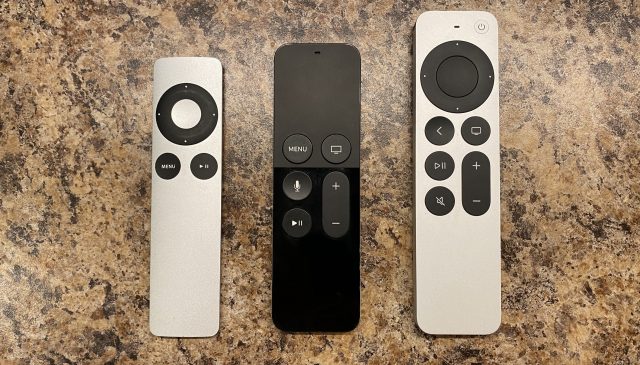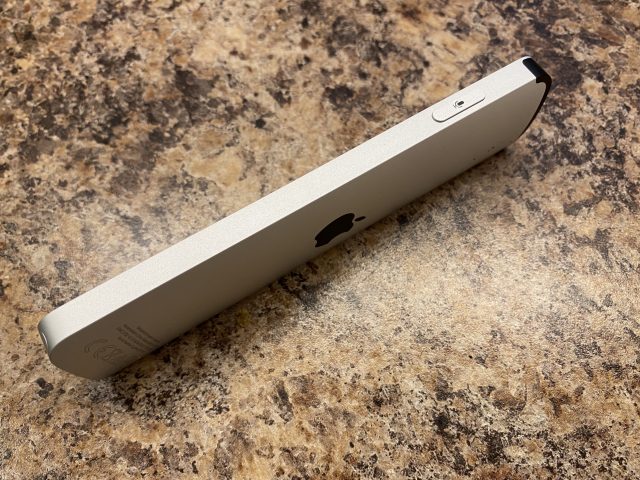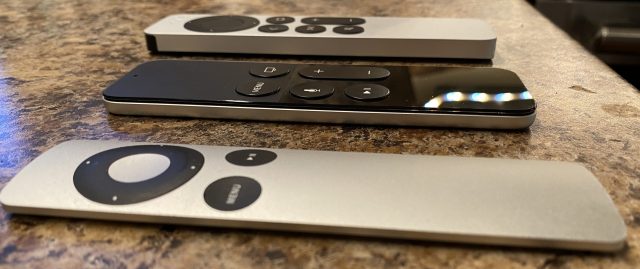
I have a confession to make. Despite having written Take Control of Apple TV back in 2014 and maintained it since, I don’t use the Apple TV often anymore. I don’t watch much TV these days, and the rest of the family has grown fond of the Roku software built into our TCL TV.
A big part of why the Apple TV fell by the wayside in our house was the awful Siri Remote that Apple has been packing in the box since 2015. I didn’t explicitly hate it, but over the years, I simply avoided using it. Often, that was because I couldn’t even find it, leading me to use Apple’s Remote app and later the remote built into the iOS Control Center.
That was in stark contrast to the aluminum remote that shipped with the second- and third-generation Apple TV boxes. Even though it easily fell between couch cushions, I often found myself fiddling with it while watching TV, running my fingers along the smooth aluminum. It felt nice and was satisfying to use.
The chief sin of the original Siri Remote was that it tried to be all things to all people. It’s a TV remote! It’s a game controller! It’s a floor wax! It’s a dessert topping! The result was a device that made almost no one happy. The touchpad surface was too sensitive for scrubbing through video, lacked the necessary precision for anything beyond the most casual games, and made even casual games frustrating. To top it all off, the build quality seemed cheap, at least by Apple standards. The buttons felt mushy, and since much of it was made of glass, we always handled it with kid gloves or enveloped it in rubbery cases. That original Siri Remote easily makes the top ten list of worst Apple designs.
I don’t know why it took so long to correct such an obvious faux pas, but Apple finally has, with a new remote called… the Siri Remote. Perhaps Apple gave the second-generation Siri Remote the same name as the previous abomination in an effort to overwrite it in search engines and the history books of industrial design.
Next-Generation Design
The second-generation Siri Remote is a merging of the previous two Apple TV remotes. Apple has brought back the all-aluminum body, directional ring, and clicky buttons from the remote that preceded the original Siri Remote. But it still has a touchpad of sorts, officially called the Clickpad, that resides in the center of the directional ring and serves as both touchpad and select button (technically, the entire ring plus the central touch surface is the Clickpad).

There are new touches too. The Siri Remote now features a power button. If you have an HDMI-CEC-compatible television, the power button can also turn your TV on and off. Even more welcome for some is the new Mute button, which you can use with HDMI-CEC or by programming the volume buttons to control your TV or soundbar volume (in Settings > Remotes and Devices > Volume Control). Finally, Apple moved the Siri button to the side, reducing accidental invocations.

Unlike the pancake-flat original Siri Remote, this one brings back sharp aluminum edges and a curved back. It’s much thicker (0.36 inches / 9.25 mm) and heavier (2.2 ounces / 64 g) than either of its forebears, though I wouldn’t describe it as thick or heavy.

In fact, the second-generation Siri Remote has made me surprisingly nostalgic. Like the old aluminum Apple TV remote, I find myself holding it while watching a movie. It’s just so pleasant to hold and use. It makes me want to go to the trouble of bypassing the Roku interface, switching inputs, and hunting down something to watch (though the new power button combined with HDMI-CEC makes it easy to turn the TV and Apple TV on and switch to the input with a single press). I find myself using Siri to turn on subtitles or dim the lights just because its side button is satisfying to press.
Like the previous model, the new one charges through a Lightning port at the bottom. Apple doesn’t specify a battery life, but if it’s anything like the previous model, you shouldn’t need to charge often, and charging shouldn’t take long. Battery life and ease of charging were not among the complaints I had about the original Siri Remote.
Pairing the Second-Generation Siri Remote
The tiny instruction manual with even tinier type obscures Apple’s ever-so-clever and painless pairing method: simply bring the Siri Remote within a few inches of the Apple TV box and press the Back and Volume Up buttons. It works like a charm, even if your Apple TV is asleep.
Kudos to the Clickpad
After the initial excitement of Apple’s announcement of the second-generation Siri Remote had worn off, I was skeptical of how well such a tiny touchpad would work. As it turns out, less is more.
The large size and sensitivity of the original Siri Remote touchpad made it anxiety-inducing. The Clickpad is much more precise, thanks largely to the raised directional ring acting as a buffer between errant swipes and the touch surface. Unlike the original Siri Remote or the iPhone apps, I find myself actually enjoying swiping through the Apple TV interface on the second-generation Siri Remote.
The touch surface in the center of physical directional buttons is a stroke of genius. Swipe left, but don’t quite select what you wanted? Just press the left arrow—your thumb is already there. The two complement each other nicely, but if you want strictly physical controls, you can disable the touch surface entirely in Settings > Remotes and Devices > Clickpad.
Interestingly, if you play casual games on your Apple TV, I found that the second-generation Siri Remote actually works better in games like Oceanhorn because its touchpad isn’t so sensitive. That said, I don’t recommend playing video games with a TV remote. It’s like trying to dig a hole with a manure fork instead of a shovel. They’re both garden tools, but only one is right for the job.
The Original iPod Sends Its Regards
Back when I would stay up late watching TV with an older Apple TV, I would often find myself rubbing my thumb along the directional ring, scrolling through content like an iPod click-wheel. Apparently, I wasn’t alone.
The Clickpad’s directional ring is also touch-sensitive, so that, in theory, you can scroll content just like an old iPod. It was one of the features I was most excited to try but turned out to be one of my biggest disappointments.
It works, but the software support isn’t quite there yet. If you’re watching a movie in the Apple TV app, running your finger around the directional ring registers as if you were pressing or swiping up, which reveals the timeline and the Picture-in-Picture button. To actually scrub through content, you must first pause the movie.
Third-party apps like YouTube are often confused by the directional ring. When I scrub through a YouTube video’s timeline, it often takes a second or two to respond, putting me in a random location. In the Amazon Prime Video app, the ring works in reverse: rotating from right to left moves forward and left to right moves backward.
I suspect that the directional ring’s touch surface emulates the directional buttons rather than sending unique inputs. If so, that feels like a mistake, albeit an understandable one, and I hope Apple corrects it in a future software update.
Quibbles and Complaints
Beyond the disappointment of the directional ring, Apple left out some obvious hardware capabilities that are hard to excuse given the second-generation Siri Remote’s $59 price.
Most glaring is the lack of tracking through Find My, especially given that Apple announced this remote alongside AirTag. I can now easily track keys, bags, cars, and even cats, but not my Apple TV’s remote without putting it in a clunky case that also accommodates an AirTag.
Tim Twerdahl, Apple’s vice president of product marketing for home and audio, offered an explanation to MobileSyrup, and frankly, it’s infuriating:
With the changes we’ve made to the Siri Remote—including making it a bit thicker so it won’t fall in your couch cushions as much—that need to have all these other network devices find it seems a little bit lower.
First of all, the second-generation Siri Remote can still easily slip between couch cushions unless you’re like us and keep a cover over the couch—nearly eight years of parenting have made us slightly wiser. Secondly, remotes disappear all the time for reasons unrelated to the couch: being covered by a stray magazine, falling behind the entertainment center, or being carried away by a mischievous child. I’ve long suspected that no one in Apple leadership lives with young children, and the omission of Find My support doesn’t disabuse me of that notion.
Granted, this is the most first-world of problems, but the inclusion of Find My could have made a good product truly brilliant.
Another annoyance is the loss of the gyroscope and accelerometer from the previous model, making a handful of Apple TV games incompatible with the new remote. Twerdahl explained it away by saying you can use an Xbox or PlayStation controller with the Apple TV now, which is fair enough. Still, I don’t see any technical reason that Apple couldn’t have maintained that sliver of backward compatibility.
Including the gyroscope and accelerometer could also have enabled a gestural interface in tvOS, where you’d simply point the remote at the TV screen and move it in different directions to move the selection around. Such a change might have been a big win for tvOS 15.
I suspect that Apple made these exclusions to cut component costs and improve margins. But this is a premium remote for a premium price and shouldn’t skimp on such obvious features.
Good Design Matters
The second-generation Siri Remote isn’t perfect, but it’s a sufficient mea culpa that you might want to toss your original Siri Remote into the back of the closet as a just-in-case backup. I can’t tell you if it’s the best remote for an Apple TV, but it’s certainly the most improved one.
Replacing your existing Siri Remote will cost you $59. You can also get one with a new Apple TV HD (which no one should buy anymore at $149) and the updated Apple TV 4K, starting at $179.
If you own an Apple TV 4K, $59 is absolutely worth it to make your Apple TV experience vastly more enjoyable. If you’re happily using an Apple TV HD, you’ll appreciate the second-generation Siri Remote, but you might instead consider making the jump to an Apple TV 4K for $120 more.
